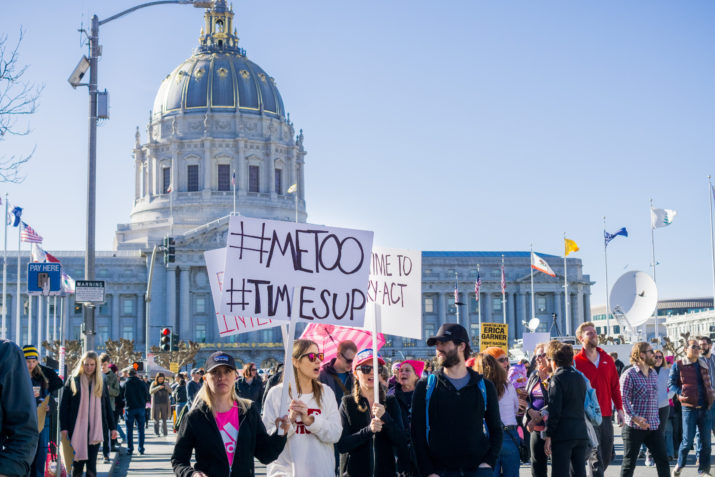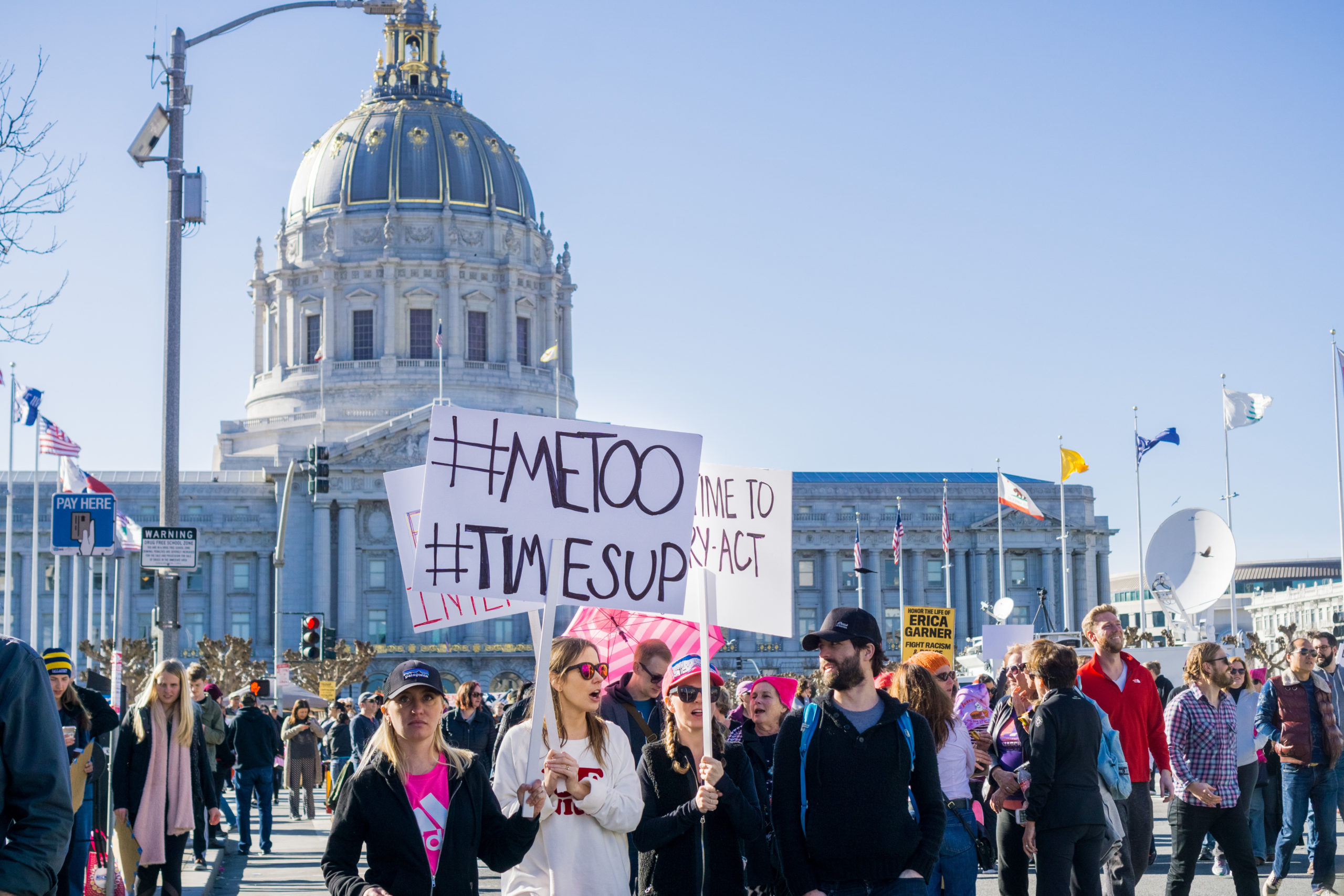

A special feature, Me Who? The Audibility of a Social Movement.
The prevalence of the phrase “MeToo” in popular discourse met a watershed moment in 2017, when the movement elevated from a grassroots campaign to a position on the public agenda of numerous nation states. It was the illumination of the disturbing behavior of Harvey Weinstein by the New York Times and the New Yorker that quickly spurred a tidal wave of social media disclosures of sexual assault and harassment under the hashtag, and the activity was continually catalyzed by support from celebrities such as Gwyneth Paltrow and Uma Thurman. However, this high-profile interaction perhaps unsurprisingly exemplified the problematic perquisites of media attention, and the wider press was quick to adjudicate upon what was perceived as a “valid,” “legitimate,” or “credible” claim, albeit in an attempted covert manner. Mirroring scholarly insight into the endemic institutional treatment of victims of rape and sexual violence more broadly, in which disbelief and attribution of responsibility dominates the legal process (e.g. Myers 1980; Martin and Powell 1994; Grubb and Harrower 2008; Cooper 2016), Hollywood victims similarly appeared scrutinized for assumed past behavior, previous relationships, and arguably of greatest concern, their ethnicity.
Consider, for example, the account of black actress Lupita Nyongo’o that eventually broke the “party line” silence on the side of Weinstein, with his team responding that he had “a different version of events” (Wang 2017). The suspected “PR move” is far from surprising; the questioning of the “believability” of woman of color remains a prevalent theme in issues of sexual assault, with racialized efforts to discredit disclosure of harm copiously recorded in the literature (e.g. George and Martinez 2002; Donovan 2007; Dukes and Gaither 2017). Another stand out case of this in the #MeToo climate was provided by Lena Dunham, writer and actress in the HBO show Girls, who, against a backdrop of applauding women for coming forward, issued a statement claiming allegations made by Aurora Perrineau to be false. She later submitted an apology stating that she had misrepresented the extent of her knowledge of the incident (O’Connor 2018). Perhaps further frustrating this alarming asymmetrical attribution of responsibility is the fact that the true purpose of the #MeToo campaign was to provide a safe space and advocate for women of color experiencing sexual abuse and assault. Tarana Burke’s engagement on social media all the way back in 2006 kicks off the chronology of this phrase, as opposed to popular use by white counterparts a decade later. Her award for Time Person of the Year in 2017 was not only arguably a long time coming, but her visibility as a founder of the campaign remains limited to those engaged in the debate.
In the first instance, however, it must be acknowledged that despite a growing climate of disclosure, press attention often appears skewed towards concern with the men at the heart of these accusations, with the wider community seemingly wrestling with preconceptions about the perpetrators of incidents. The circus of clamor around accounts of the imprisoned banker Geoffrey Epstein’s death in his cell in 2020, for example, has grown ever still with the embroilment of the Duke of York in the plethora of accusations that surrounded him, with the affair coined a “royal crisis” (Doward 2019). The case of television star Bill Cosby similarly appeared to shock the US and beyond. It garnered vast coverage, due in large part to the whimsical view of the actor as “America’s father” (Francescani and Fisher 2019). Analogous feeling emerged for the accusations levied at USA Gymnastics national team doctor Larry Nassar; a learned man at the heart of a caring profession, and at the charge of young girls, created an audible concern for the embedded nature of this behavior in society. Although a paternalistic character assassination, in part, allowed for the conviction of these two latter examples, it must be warned that this cannot quickly be viewed as a success for the cause as it too serves to detract from the absolute nature of the crime of rape; the so-called “Harvey effect” is clearly threatened by intervening perceptions of what constitutes worse behavior.
So, what is the legal state of affairs currently? Conviction rates are low, with six powerful male figures to date – Weinstein, Cosby, Arnault, Stramper, Raniere, Mack – found guilty. Other notable cases, such as R Kelly, Blaine, and Franco, rumble on, some with charges, and others awaiting the next move. Let us not pass swiftly over the case that brought all of this to the world stage, however, and triumphantly declare a victory in the case of Weinstein. Although found guilty, the week in which this decision was delivered will also be remembered by feminists as when notorious film director Roman Polanski, still wanted in the US for the sentencing of statutory rape, was awarded at the Césars. Although actress Adele Haenel’s cries of “shame” as she walked out of the ceremony were reported upon globally, it is of little uncertainty the impact this will have (Marshall 2020).
This leads us to wonder if it is perhaps a more accurate representation of the reaction of institutions, organizational structures, and the wider public, to use the exclamation “MeWho,” both for victims and perpetrators. Of course, such a statement requires corroboration; a task that involves studying the nuance of public discourse, legal proceedings, and policy reactions, and is a task contributed to in this issue of EuropeNow. Addressing a breadth of aforementioned intersectional issues of the #MeToo movement within this context; Ebrahim and Liu address the influence of the celebrity elites – focusing the discourse of actress Alyssa Milano – while Garraio et al critically explore the movement in the wake of allegations against a national hero in Portugal. Carroll, in turn, takes a step back to consider the wider context. She draws on the work of Mackinnon to argue that structural inequalities threaten to continue in Sweden, despite recent changes to the status of consent in its domestic legislative scheme. These historical legacies are further explored by Winter in the context of Australia, with the paper driving towards the conclusion that male sexual entitlement remains deeply embedded in law and politics. In addition to these research contributions, an illuminating interview with Nancy Hendry concerning her analytical concept of sextortion and how the #MeToo moment helped to break the culture of silence about the intertwining of corruption practices and sexual violence, is a palatable take on the impact of the movement.
Overall, this special feature positions itself within the quickly growing literature on the #MeToo movement, which now includes several books and articles (e.g. Krook 2018; Boyle 2019; Fileborn and Loney-Howes 2019). The issue’s intent is to reflect on the extent and nature of change catalyzed by the #MeToo movement thus far, with the implicit task of highlighting space for beneficial development in the future. The disparagingly fickle and fleeting attention of citizens often times serves to dilute the extent of actual change following public scandals, but it’s arguable that the mounting critical mass of cases of sexual assault and harassment now punctuating the media’s gaze opens a prominent window of opportunity for the social movement on the political agenda.
Research
- “Being Passed off as Wicked Witches, That’s a Bit Much!’ When the Victims Become the Defendants” by Bronwyn Winter
- “The Unimaginable Rapist and the Backlash Against #MeToo in Portugal” by Júlia Garraio, Sofia José Santos, Inês Amaral and Alexandre de Sousa Carvalho
- “Saying #MeToo in the Swedish Legal System: The Importance of Believing Women” by Caitlin Carroll
- “Not Just Pretty Faces, They Have Powerful Voices Too: Celebrity Discourse and the #MeToo Movement” by Sumayya Ebrahim and Lisa Liu
Commentary
Interviews
Visual Art
Fiction
Reviews
- Malina reviewed by Maya Solovej
- Heroines and Local Girls: The Transnational Emergence of Women’s Writing in the Long Eighteenth Century, reviewed by Siobhán McIlvanney
Campus Spotlight: Appalachian State University
- “The Wife of Bath, Rape, and the Ethical Classroom” by Alison Gulley
- “What is the Scholar’s Role in Apocalyptic Times?” by Martha McCaughey and Scott Welsh
- “Ecofeminist Embodiment in the Anthropocene” by Kathryn Kirkpatrick
- “From the Well to the Internet: Alternative Modes of Education by Women Through History” by Lillian Livermore
- “Syllabus: Feminist Political Theory” by Nancy Love
- “Syllabus: Fat Talk: A Feminist Perspective” by Denise Martz
- “Fat Talk, Body Snarking, and Women’s Body Image: An Interview with Denise Martz” by Hélène Ducros
Sarah Cooper is a lecturer in Politics at the University of Exeter and the co-chair of the Council of European Studies’ Gender and Sexuality Research Network. Her research explores the legal and political nexus, specifically in regard to gender public policy, and she is the author of Regulating Women (Rowman and Littlefield 2016).
Koen Slootmaeckers is a lecturer in international politics at City University of London and the co-chair of the Council of European Studies’ Gender and Sexuality Research Network, and an executive committee member for UACES. Koen researches sexuality politics in Europe, particularly in the Western Balkans. His publications included the co-edited volume The EU Enlargement and Gay Politics (Palgrave, 2016) and articles in Theory and Society, East European Politics, Journal of Homosexuality, Social Problems, and Europe-Asia Studies.
References
Cooper, S. (2016) Regulating Women Rowman and Littlefield.
Donovan, R. A. (2007). To blame or not to blame: Influences of target race and observer sex on rape blame attribution. Journal of interpersonal violence, 22(6), 722-736.
Doward, J. (2019) “Prince Andrew and the royal crisis: how the Firm lost its grip” The Guardian https://www.theguardian.com/uk-news/2019/nov/23/prince-andrew-royal-crisis-firm-lost-grip
Dukes, K. N., & Gaither, S. E. (2017). Black racial stereotypes and victim blaming: Implications for media coverage and criminal proceedings in cases of police violence against racial and ethnic minorities. Journal of Social Issues, 73(4), 789-807.
https://www.nytimes.com/2020/02/28/movies/roman-polanski-cesar-awards-france.html
Fileborn, B., & Loney-Howes, R. (Eds.). (2019). # MeToo and the Politics of Social Change. Springer Nature.
Francescani, C. and Fisher, L. (2019) “Bill Cosby: A timeline of his fall from ‘America’s Dad’ to a ‘sexually violent predator’” abcNews https://abcnews.go.com/Entertainment/bill-cosby-trial-complete-timeline-happened-2004/story?id=47799458
George, W. H., & Martínez, L. J. (2002). Victim blaming in rape: Effects of victim and perpetrator race, type of rape, and participant racism. Psychology of Women Quarterly, 26(2), 110-119.
Grubb, A., & Harrower, J. (2008). Attribution of blame in cases of rape: An analysis of participant gender, type of rape and perceived similarity to the victim. Aggression and Violent Behavior, 13(5), 396-405.
Krook, M. L. (2018). Westminster too: On sexual harassment in British politics. The Political Quarterly, 89(1), 65-72.
Marshall, A. (2020) “Actors Walk Out After Roman Polanski Wins Best Director at France’s Oscars” New York Times https://www.nytimes.com/2020/02/28/movies/roman-polanski-cesar-awards-france.html
Martin, P. Y., & Powell, R. M. (1994). Accounting for the “second assault”: Legal organizations’ framing of rape victims. Law & Social Inquiry, 19(4), 853-890.
Myers, M. A. (1980). Social contexts and attributions of criminal responsibility. Social Psychology Quarterly, 405-419.
O’Connor, R. (2018) “Lena Dunham admits she lied to discredit actor Aurora Perrineau’s rape accusation” The Independent https://www.independent.co.uk/arts-entertainment/tv/news/lena-dunham-aurora-perrineau-apology-rape-murray-miller-hollywood-reporter-a8669846.html
Wang, A. (2017) “Harvey Weinstein, accused by dozens, specifically disputes Lupita Nyong’o’s harassment claims” The Washington Post https://www.washingtonpost.com/news/arts-and-entertainment/wp/2017/10/21/harvey-weinstein-accused-by-dozens-specifically-disputes-lupita-nyongos-harassment-claims/
Photo: Women’s March protesters begin to walk; #metoo and #timesup slogans written on a sign at the rally held in front of the City Hall
Published on March 10, 2020.




